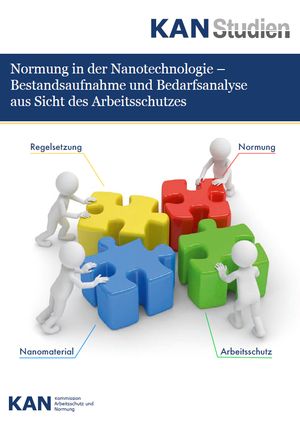KANBrief 2/17

Nanomaterials occur in diverse forms and structures. The risks associated with them are also diverse, and have in many cases not yet been studied. These materials are nevertheless already in widespread use. In standardization, too, numerous questions have yet to be answered. What documents concerning nanomaterials are available? Do they include content of relevance to occupational safety and health? How do OSH experts maintain an overview? Answers can be found in a new KAN study (pdf, in german) (Project partner: Dr Wolfgang Luther, VDI Technology Centre).
In nanotechnology, the structural properties of materials are modified by miniaturization by several orders of magnitude. Nanomaterials can already be found in numerous products. Examples are titanium dioxide in sun screen products and wall paints, silicon dioxide in lacquers and foods, and carbon nanotubes in composite materials. Many effects of nanomaterials are however still unclear, and the number of research projects is high.
Nanomaterials present a challenge for occupational safety and health over the entire product life-cycle, from manufacture, processing and use, through to disposal. Respirable particles are of particular importance in this context. Issues of fire and explosion protection may also be relevant during risk assessment. In Germany, tasks involving manufactured nanomaterials at the workplace fall under the general requirements of the Hazardous Substances Ordinance (GefStoffV). Announcement on Hazardous Substances (BekGS) 527 (manufactured nanomaterials) of the Committee for Hazardous Substances (AGS) provides more specific recommendations. In addition, numerous European and international standardization documents governing nanomaterials exist, some of which also govern OSH aspects. The situation is however confusing, and selective influencing of occupational safety and health difficult.
Who does what: standardization under the magnifying glass
In the study entitled "Standardization in nanotechnology – Status review and requirements analysis from the occupational safety and health perspective", KAN has commissioned an analysis of European and international standardization documents, and has formulated recommendations for action based upon the results. These provide experts concerned with orientation in the plethora of standards concerning nanotechnology.
The survey covered 260 documents of direct relevance to nanomaterials. A large part of the standardization activity is conducted in the nano-specific standardization committees ISO/TC 229 – Nanotechnologies, IEC/TC 113 – Nanotechnology for electrotechnical products and systems, and CEN/TC 352 – Nanotechnologies. Nano-related aspects are however also important in other standards committees, for example those concerned with the extension of methods and measurement technology into the nano-range.
The majority of documents describe test and measurement methods; further documents address terminology, material specifications and descriptions of processes, or serve as guidance documents. Around 30 documents (primarily technical reports and technical specifications) are of direct relevance to occupational safety and health. They concern aspects that are already regulated in Germany by the state or the accident insurance institutions, for example the measurement and assessment of exposure, or measures for risk management. The annex to the study contains information on the purpose and content of these documents, and an assessment of their relevance to occupational safety and health.
Recommendations
Essential contradictions between standards and national OSH rules are not apparent at the present time. Many documents are however still under development, and their precise content is as yet unclear. These projects must be monitored closely by OSH representatives. In order for German OSH expertise to be submitted in a coordinated form to the standardization process in the future, the experts scattered across numerous committees must be networked closely. The study recommends that the KAN Secretariat create a national strategy group, the tasks of which are to include the following:
Further recommendations for action are addressed through the BMAS to the European Commission, and through DIN to CEN and ISO.
Dr. Anja Vomberg
vomberg@kan.de